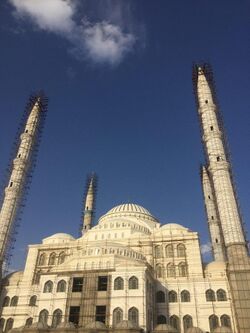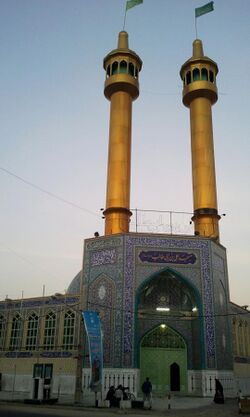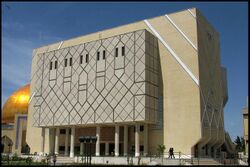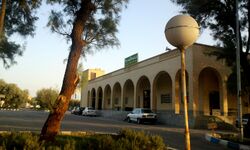Zahedan
Topic: Place
 From HandWiki - Reading time: 7 min
From HandWiki - Reading time: 7 min
Zahedan زاهدان | |
|---|---|
City | |
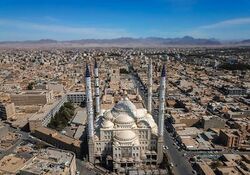 Makki Mosque in Zahedan | |
| Coordinates: [ ⚑ ] : 29°30′09″N 60°51′21″E / 29.5025°N 60.85583°E[1] | |
| Country | |
| Province | Sistan and Baluchestan |
| County | Zahedan |
| District | Central |
| Government | |
| • Mayor | Mohammad Amir Barahuyi[2] |
| Elevation | 1,352 m (4,436 ft) |
| Population (2016)[3] | |
| • Urban | 587,730 |
| Time zone | UTC+3:30 (IRST) |
| Area code(s) | +98-54 |
| Climate | BWh |
| Website | zahedan |
Zahedan (Balochi and Persian: ![]() زاهدان, Zâhedân [zɒːheˈd̪ɒːn])[lower-alpha 1] is a city in the Central District of Zahedan County, Sistan and Baluchestan province, Iran and serves as capital of the province, county and district.[6] It is near the Iran-Pakistan border.
زاهدان, Zâhedân [zɒːheˈd̪ɒːn])[lower-alpha 1] is a city in the Central District of Zahedan County, Sistan and Baluchestan province, Iran and serves as capital of the province, county and district.[6] It is near the Iran-Pakistan border.
At the 2006 census, its population was 552,706 in 109,488 households.[7] The following census in 2011 counted 560,725 people in 134,088 households.[8] The 2016 census showed a population of 587,730 people in 146,717 households.[3]
The city was the site of a deadly crackdown in October 2022, with dozens citizens killed by pro-governmental forces.[9] Over 90 people were killed.[10] Two senior police officials were fired in the aftermath of the crackdown.[10] On 28 October, there were protests in Zahedan and security forces fired on protestors, killing 1 and injuring 14.[10]
On 3 November 2022, the Shi'i cleric and Khamenei loyalist Sajjad Shahraki was assassinated in Zahedan.[11][12] The next day, there were widespread protests in the city and Revolutionary Guards and other armed forces fired on protestors.[11]
Name
The original name of the city was Duzzap (Persian: Duzdab, meaning "Water Stolen"), which it had received due to the abrupt floods into the valley. The name was later changed to Zahedan (Persian for "hermits") during Reza Shah's visit in 1929.[13]
History
Mention of Zahedan first appears in sources in August 1849. However, the city first truly started to grow during the early 20th-century.[14] During World War I it became the westernmost terminal of the Zahedan railway station, which reached as far as Quetta in the northern part of what was then British Baluchistan.[15]
Geography
Zahedan is connected by rail to nearby Pakistan and is near to Afghanistan. It is about 41 km (25 mi) south of the tripoint of the three countries and at an altitude of 1,352 m (4,436 ft) above sea level and 1,605 km (997 mi) from the Iranian capital of Tehran.
Climate
Zahedan has a hot desert climate (Köppen: BWh, Trewartha: BW). Precipitation is very low, and mostly falls in winter.
Zahedan experiences very hot summers, there are 84.7 days per year with maximum temperature above 35 °C (95 °F), of which 7 days have a daily maximum above 40 °C (104 °F).. Winters are quite cold with minimum temperatures below 0 °C (32 °F) for 43.7 days annually. Zahedan also experinces 81.3 days a year with haze.[16]
Script error: No such module "weather box".
Script error: No such module "weather box".
Demographics
Although the surrounding area has many ancient sites, Zahedan itself developed mainly in the 20th century. Before being chosen as the provincial administrative center in the 1930s, Zahedan was a small village. Its population reached 17,500 by 1956 and increased more than fivefold to 93,000 by 1976. After 1980, large numbers of refugees fleeing the Soviet invasion of Afghanistan helped triple the population of Zahedan to more than 281,000 by 1986, a number which has since doubled again.
Education
Zahedan is the home of the Islamic Azad University of Zahedan,[19] the Zahedan University of Medical Sciences[20] and the University of Sistan and Baluchestan. Besides, the largest Sunni seminary, Darululoom Zahedan, is located in Zahedan. There are some other religious Sunni schools in the city and the vicinity.
Sports
In April 2008 the 70 billion IRR (about 2.5 million USD) Zahedan Stadium was built with a seating capacity of 15,000 people. It was inaugurated on 18 April 2008 with a friendly football game between Honarmandan (Artists) and a local team.
Economy
Zahedan is the main economic center of the region and home to many small- and medium-scale industries. Its main products include cotton textiles, woven and hand-knotted rugs, ceramics, processed foods, livestock feed, processed hides, milled rice, brick, reed mats and baskets.
Transport
Zahedan is served by Zahedan International Airport.
Highway 95 links Zahedan to Tehran and Mashhad in the north and the port of Bandar Chabahar on the Sea of Oman in the south, and Highway 84 to the Pakistani city of Quetta in the east and to Kerman in the west.
For decades the 5 ft 6 in (1,676 mm) broad gauge (Indian subcontinent system) railway exists from Zahedan station to/from Quetta's station in Pakistan, the Quetta–Taftan Railway Line. Beyond this, west, a standard gauge line was completed from Zahedan to Kerman linking the city with the rest of the Iranian rail network.[21] This flowed from a 18 May 2007 MOU for rail co-operation (of Pakistan and Iran) under which the line was to be completed by December 2008.[22] It was completed with an opening ceremony on 19 June 2009.[23] This means that Zahedan hosts the break of gauge between the Islamic Republic of Iran Railway's standard gauge tracks of the Trans-Iranian Railway and Pakistan Railway's broad gauge aforementioned.
Chabahar–Zahedan railway
In May 2016, during Indian Prime Minister Narendra Modi's trip to Iran, agreement was signed to develop two terminals and five berths at Port of Chabahar and to build a new railway between Chabahar and Zahedan, as part of North–South Transport Corridor, by Indian Railways's public sector unit Ircon International.[24] This proposal is under study and consideration, a via Kerman connection to the port of Chabahar.[24]
In July 2016, India began shipping US$150 million of tracks to Chabahar[25] to build the US$1.6 billion line, for which India pledged additional US$400 million and Iran has also allocated US$125 million in December 2016, thus taking the total allocation to US$575 million (out of US$1.6 billion needed) by the end of 2016.[26]
Notable people
- Mohammad Jorjandi, cybercrime expert
See also
- 2007 Zahedan bombings
- 2009 Zahedan bombings
- July 2010 Zahedan bombings
- 2019 Khash–Zahedan suicide bombing
Notes
References
- ↑ OpenStreetMap contributors (22 April 2023). "Zahedan, Zahedan County" (Map). OpenStreetMap. Retrieved 22 April 2023.
- ↑ https://www.isna.ir/news/1400070805397
- ↑ 3.0 3.1 "Census of the Islamic Republic of Iran, 1395 (2016)" (in fa) (Excel). The Statistical Center of Iran. p. 11. https://www.amar.org.ir/Portals/0/census/1395/results/abadi/CN95_HouseholdPopulationVillage_11.xlsx.
- ↑ Skrine, Clarmont (1962). World War in Iran. Constable & Company, Ltd.. p. 68.
- ↑ Zahedan can be found at GEOnet Names Server, at this link, by opening the Advanced Search box, entering "-3088799" in the "Unique Feature Id" form, and clicking on "Search Database".
- ↑ Habibi, Hassan (21 June 1369). "Approval of the organization and chain of citizenship of the elements and units of the national divisions of Sistan and Baluchestan province, centered in the city of Zahedan" (in fa). Ministry of Interior, Defense Political Commission of the Government Board. https://rc.majlis.ir/fa/law/show/113038.
- ↑ "Census of the Islamic Republic of Iran, 1385 (2006)" (in fa) (Excel). The Statistical Center of Iran. p. 11. http://www.amar.org.ir/DesktopModules/FTPManager/upload/upload2360/newjkh/newjkh/11.xls.
- ↑ "Census of the Islamic Republic of Iran, 1390 (2011)" (in fa) (Excel). The Statistical Center of Iran. p. 11. https://irandataportal.syr.edu/wp-content/uploads/Sistan-and-Baluchestan.xls.
- ↑ Engelbrecht, Cora; Tabrizy, Nilo; Jhaveri, Ishaan (2022-10-14). "‘It Was a Massacre’: How Security Forces Cracked Down in Southeastern Iran" (in en-US). The New York Times. ISSN 0362-4331. https://www.nytimes.com/2022/10/14/world/middleeast/iran-zahedan-crackdown.html.
- ↑ 10.0 10.1 10.2 "Iran protests: Fresh clashes in Zahedan". BBC News. 28 October 2022. https://www.bbc.com/news/world-middle-east-63430246.
- ↑ 11.0 11.1 Daragahi, Borzou (4 November 2022). "‘Death to the dictator’: Dozens killed as Iran’s southeast erupts in political violence". The Independent. https://www.independent.co.uk/news/world/middle-east/iran-baluchistan-mahsa-amini-protests-b2217865.html.
- ↑ "Iranian cleric killed in flashpoint city of Zahedan - IRNA". Reuters. Islamic Republic News Agency. 3 November 2022. https://www.reuters.com/world/middle-east/cleric-flashpoint-iranian-city-zahedan-has-been-killed-irna-2022-11-03/.
- ↑ Dudoignon 2017, p. 119.
- ↑ Dudoignon 2017, pp. 118–119.
- ↑ Bosworth 2002, p. 387.
- ↑ 16.0 16.1 "World Meteorological Organization Climate Normals for 1991-2020: Zahedan" (CSV). NOAA. https://www.nodc.noaa.gov/archive/arc0216/0253808/2.2/data/0-data/Region-2-WMO-Normals-9120/Iran/CSV/Zahedan_40856.csv.
- ↑ 17.0 17.1 "Zahedan Climate Normals 1961–1990". National Oceanic and Atmospheric Administration. ftp://ftp.atdd.noaa.gov/pub/GCOS/WMO-Normals/RA-II/IR/40856.TXT.
- ↑ "Yearly & Monthly Weather - Zahedan, Iran". https://www.weather-atlas.com/en/iran/zahedan-climate.
- ↑ "دانشگاه آزاد اسلامی واحد زاهدان". http://www.iauzah.ac.ir/.
- ↑ "خانه". http://www.zaums.ac.ir/default.page.
- ↑ Dr John Stubbs (1 January 2007). "Closing the gap from Bam to Zahedan". Railway Gazette International. http://www.railwaygazette.com/news/single-view/view/10/closing-the-gap-from-bam-to-zahedan.html.
- ↑ "Intelligence". Railway Gazette International. 1 July 2007. http://www.railwaygazette.com/news/single-view/view/10/intelligence-july-2007.html.
- ↑ "Zahedan | Railways of Afghanistan". http://www.andrewgrantham.co.uk/afghanistan/tag/zahedan/.
- ↑ 24.0 24.1 "Chabahar port: India to build 500 km rail line on southern coast of Iran as part of transit corridor to Afghanistan". 23 May 2016. https://www.dnaindia.com/business/report-chabahar-port-india-to-build-500-km-rail-line-on-southern-coast-of-iran-as-part-of-transit-corridor-to-afghanistan-2215791.
- ↑ "India to export USD 150 mn rails for Chabahar port next month". 16 June 2016. https://indianexpress.com/article/india/india-news-india/india-to-export-usd-150-mn-rails-for-chabahar-port-next-month-2857029/.
- ↑ "$125m for Chabahar-Zahedan Railroad". 24 December 2016. https://financialtribune.com/articles/economy-domestic-economy/56102/125m-for-chabahar-zahedan-railroad.
Sources
- Bosworth (2002). "Zāhidān". in Bearman, P. J.. The Encyclopaedia of Islam, New Edition, Volume XI: W–Z. Leiden: E. J. Brill. pp. 387. ISBN 978-90-04-12756-2. https://referenceworks.brillonline.com/entries/encyclopaedia-of-islam-2/zahidan-SIM_8075.
- Dudoignon, Stéphane A. (2017). The Baluch, Sunnism and the State in Iran: From Tribal to Global. Oxford University Press. ISBN 978-0-19-065591-4. https://books.google.com/books?id=rWlNDwAAQBAJ&dq.
External links
 Zahedan travel guide from Wikivoyage
Zahedan travel guide from Wikivoyage- Municipality of Zahedan
- Zahedan University of Medical Sciences
- Official Website of the Sunni Community of Iran, Sunnionline
 |
 KSF
KSF

